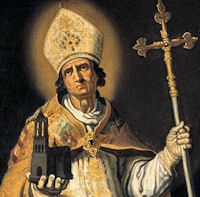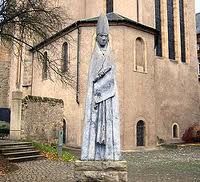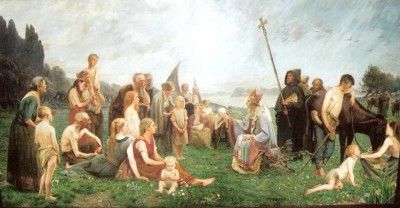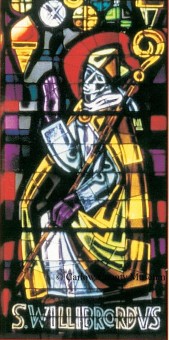
Summary: St Willibrord, Bishop and Missionary. Willibrord was born in Northumbria in 658, entered the Benedictine order and sent to Rathmelsige (probably Clonmelsh in County Carlow in Ireland ) to study. After ordination he was sent with eleven companions to evangelize Frisia, established a mission at Utrecht and in 695 was ordained archbishop of Utrecht by Pope Sergius I, founded a monastery at Eichtemach in Luxembourg in 700, where he died in 739.
 Willibrordis not a name we associate with Irish saints. A native of Yorkshire, he spent some years of his training and was ordained in Ireland, so he is included in the Irish calendar of saints for this day. He was one of the first missionaries to what are now known as the Benelux countries: the image is a commemorative postage stamp from Luxemburg.
Willibrordis not a name we associate with Irish saints. A native of Yorkshire, he spent some years of his training and was ordained in Ireland, so he is included in the Irish calendar of saints for this day. He was one of the first missionaries to what are now known as the Benelux countries: the image is a commemorative postage stamp from Luxemburg.
Patrick Duffy gathers what is known about him.
The Irish Connection
Willibrord was a native of Yorkshire and was educated from an early age by St Wilfrid at Ripon. He was professed at fifteen and when Wilfrid was dislodged in 678, Willibrord went with two companions Egbert and Wigbert to Rath Melsigi in Ireland for further studies and formation. (Rath Melsigi, which is mentioned by Bede, is variously located at Clonmelsh, Co Carlow, at Mellifont, Co Louth, and at Mayo where Anglo-Saxon Gerald and his monks set up a monastery after the Synod of Whitby.) He was ordained priest in Ireland and in 690 returned to England with his companions.
Mission
Egbert had wanted to evang elise Frisia, but, instructed by a vision, he went to Iona to bring the Roman usage there. He persuaded his companions to go to Frisia. Wigbert went for two years and returned without success. Willibrord set out with a band of monks and was well received by Pepin of Herstal, duke and prince of the Franks.
elise Frisia, but, instructed by a vision, he went to Iona to bring the Roman usage there. He persuaded his companions to go to Frisia. Wigbert went for two years and returned without success. Willibrord set out with a band of monks and was well received by Pepin of Herstal, duke and prince of the Franks.
Consecration by Pope Sergius I
Willibrord’s first action was to visit Rome where he obtained approval for his mission and relics to set up churches from Pope Sergius I (687-701). His mission prospered and in 695, with Pepin’s recommendation, he went to Rome again and was consecrated archbishop of the Frisians and set up his metropolitan see at Utrecht.
Monastery at Echternach
In 701 Willibrord established an important monastic centre at Echternach in what is now eastern Luxemburg. To this he invited some monks from Ireland and it later developed as an important library and scriptorium in the Frankish empire. After the death of Pepin in 714 the pagan Frisian prince Radbod drove Willibrord out of Utrecht, but on Radbod’s death in 719, Willibrord was able to move not only into West Frisia, but also east and north into Germany and Denmark.
 Missionary Methods
Missionary Methods
Willibrord’s missionary methods show his conviction of the power of the Christian religion. In Denmark he bought thirty slave-boys whom he educated as Christians. In Heligoland he flouted the pagan custom of not drawing water without observing the strictest silence when he baptised three persons in a fountain and pronouncing the words aloud. He also killed some sacred cows for his companions to eat and incurred no retribution.
St Boniface joined Willibrord for three years before moving on further into Germany. Similar stories are told about Boniface and the cutting down the tree sacred to the god Thor and which people say is the origin of the Christmas tree.
The Calendar of St Willibrord
This is an 8th century manuscript now in the National Library in Paris, which seems to have been written as a personal liturgical calendar of Willibrord and used in his household. It provides an index to those saints who were widely honoured in early eighth-century Europe, but also little-known saints from places as far away as Constantinople and Syria. A facsimile of the manuscript itself with an introduction and commentary on the saints commemorated was published for the Henry Bradshaw Society by H.A. Wilson (d.1927), one of the England’s outstanding liturgical scholars.
 Death and Influence
Death and Influence
Willibrord died aged eighty-one at his monastery at Echternach. Very soon after his death he was venerated as a saint and pilgrims came to his grave. St Bede (672-735) wrote an edifying account of his penance, devotion and charity and St Boniface (672-754) mentions him in a letter, so that his reputation soon spread throughout northern Europe. Alcuin (735-804) wrote a biography some years after his death. Willibrord is seen as a patron saint of the Benelux countries.
An annual dancing procession takes place in Echternach on Whit Tuesday to honour this saint of truly European dimension. Dáibhí Ó Cróinín, professor of medieval Irish history at NUIG, argues for a connection through Willibrord between Irish and Echternach manuscripts and between the procession there and Irish dancing.